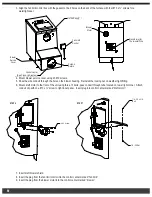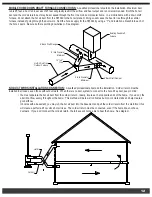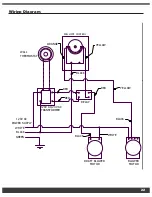
16
Draft Blower and Spin Draft:
The front draft blower plays an important role in the operation of your Shelter Furnace. When the wall thermostat calls for heat, the draft
motor turns on and supplies fresh air into the firebox producing a hotter fire, which in turns provides more heat in the heat chamber. The
heat is then sent through the duct system throughout your home. When the wall thermostat temperature is met, the draft blower shuts off
until the thermostat calls for heat, beginning the cycle again. The draft blower has a slide cover located on the side of the motor that is
factory preset, with an opening of approximately 3/8”. The cover should be fully closed only when there is a power failure and electricity
is lost. With the cover closed, no air is introduced into the firebox, then the fire dies, preventing the furnace from possible overheating
and damage. The manual combustion air spin damper control on the ash door should be set with a 1/8 inch gap. To begin, adjust slowly
by making 1 rotation at a time to find the correct air setting.
Creosote Formation and Need for Removal:
When wood is burned slowly, it produces compounds in exhaust smoke, which combine with expelled moisture to form creosote. The
creosote vapors condense in the relatively cooled chimney flue of a slow burning fire. As a result, creosote residue accumulates on the
flue lining. When ignited, this creosote makes an extremely dangerous fire in the chimney. The chimney connector and the chimney
should be inspected at least twice monthly during the heating season to determine if a creosote build-up has occurred. If creosote has
accumulated it should be removed to reduce risk of a chimney fire.
Creosote Prevention:
To help prevent the formation of creosote within the flue, ALWAYS BURN DRY, SEASONED WOOD. Dry wood burns hotter, allowing flue
gases to maintain temperatures above 212°F which should prevent the formation of creosote in the chimney. If the flue gas temperature
falls below 212°F, condensation occurs causing creosote formation and accumulation within the chimney.
As an added precaution, periodic chimney inspections are recommended during the heating season to determine if creosote formation
has occurred. For safety and efficiency, it is recommended that the chimney system be inspected and cleaned prior to each heating
season.
Power Failure:
In case of power failure, to prevent your Shelter Furnace from over-heating and causing damage to the electrical components, follow
these steps:
• Ensure that the bypass rod is pulled out, allowing heat to go up the chimney.
• Close the spin damper control on the ash door.
• Close the slide cover on the side of the draft motor.
• Do NOT add more fuel (coal or wood) to the firebox.
There is no warranty on electrical components damaged due to power failure.
slide cover to
make adjustment
OPEN
CLOSE













































